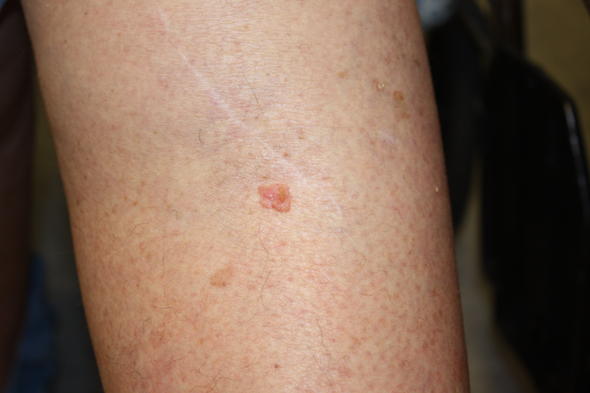
Photograph showing a person’s leg with a skin cancer lesion that looks pink and raised.
With over 10,000 of new cases of skin cancer diagnosed in Ireland every year and numbers rising steadily, the HSE National Cancer Control Programme (NCCP) is this week advising people in Donegal to enjoy the good weather but to protect themselves against skin cancer.
Despite being the most common cancer in Ireland, skin cancer can be prevented. There were 300 new cases in Donegal last year.
According to Dr. Patrick Ormond, Consultant Dermatologist, St. James’s Hospital: “We need to get into the habit of protecting our skin every day but especially from March to September.
“Over 75% of our population have ‘Celtic skin type’ where we freckle and burn easily. We tan with difficulty, or not at all and we carry the highest risk of getting skin cancer. People with a fair complexion need to be extra careful in the sun. We can protect our skin by covering up (hat, sunglasses, long sleeved clothing), seeking shade and using a ‘broad spectrum’ sunscreen with a minimum SPF 30.”
Ultraviolet rays (UVA and UVB) from the sun or sunbeds cause 95% of skin cancers and eye damage including cancer of the eye.
Explaining the best approach to staying safe in the sun, the HSE advises that everyone should be aware of their skin type.
Dr. Ormond added: “A person’s skin type is controlled by their genes. This cannot be changed. There are six different skin types. Knowing your skin type can help you understand how UV rays will affect your skin.”
The UV index measures the strength of the sun’s UV rays. The higher the UV index, the higher the risk of skin and eye damage. When the index is three or higher, you need to cover up, seek shade and apply ‘broad-spectrum’ sunscreen SPF 30.
Stressing the importance of avoiding sunbeds, Dr. Ormond noted: “We strongly urge people to never use a sunbed. People who use them before the age of 35 increase greatly increase their risk of getting a melanoma, which is the most serious of all skin cancers.”
Dr. Ormond also outlined the following tips on being sun safe:
Seek Shade: UV rays are the most intense between 11am and 3-4pm, so limit sun exposure during this time.
Cover up: Wear loose long-sleeved shirts and long pants. 95% of UV rays are blocked by cotton. Wear a wide brimmed hat that shades the head, neck, ears and face.
Wraparound sunglasses: Wear sunglasses that block as close to 100% UVA and UVB as possible. Sunglasses are just as important for children as they are for adults and can prevent cataracts in later life.
Wear sunscreen: Use a ‘broad-spectrum’ sunscreen that protects against UVA and UVB; – SPF minimum 30 (protects against UVB) and look for these signs (symbols) for UVA protection. Apply at least 20 minutes before going out in the sun and reapply every two hours. The amount of sunscreen that’s needed to cover the body of an average adult is around six full teaspoons of lotion. It is important to know that sunscreen use alone is not adequate protection against UV rays; you need to be aware of your skin type and how strong the UV index is. Babies should be kept of direct sunlight. People who are at high risk of skin cancer should use SPF 50.
Know your moles: Melanoma is the most dangerous form of skin cancer. Every year, over 900 new cases of melanoma are diagnosed in Ireland. It is the third most common cancer diagnosed in 15 – 44 year age group. Dr. Ormond stressed that “when caught early, this type of cancer can be treated effectively. However, if left untreated, melanoma can spread to other parts of the body. There are many factors that increase the risk of someone developing melanoma. These include a person with many abnormal moles, or a large number of moles – more than 50; fair complexion (fair skin, blue eyes, red/blonde hair); having had a previous melanoma or other non-melanoma skin cancer; immunosuppression (anyone who for example has had a transplant or is on immunosuppressive medication); anyone who has had a family history of melanoma; anyone with a history of childhood sunburn or anyone who has used a sunbed.” For more information please see the National Melanoma Guidelines .
Noting that sun exposure is the best natural resource of Vitamin D and is essential for bone health, Dr. Ormond explained that “the amount of time needed in the sun to make enough Vitamin D varies from person to person. It depends on a person’s skin type, amount of skin exposed, season and the time of day. People can make enough Vitamin D from short, sunlight exposure on a bright day, for example 10-20 minutes exposure to the face and hands is considered sufficient.”
Tags:







